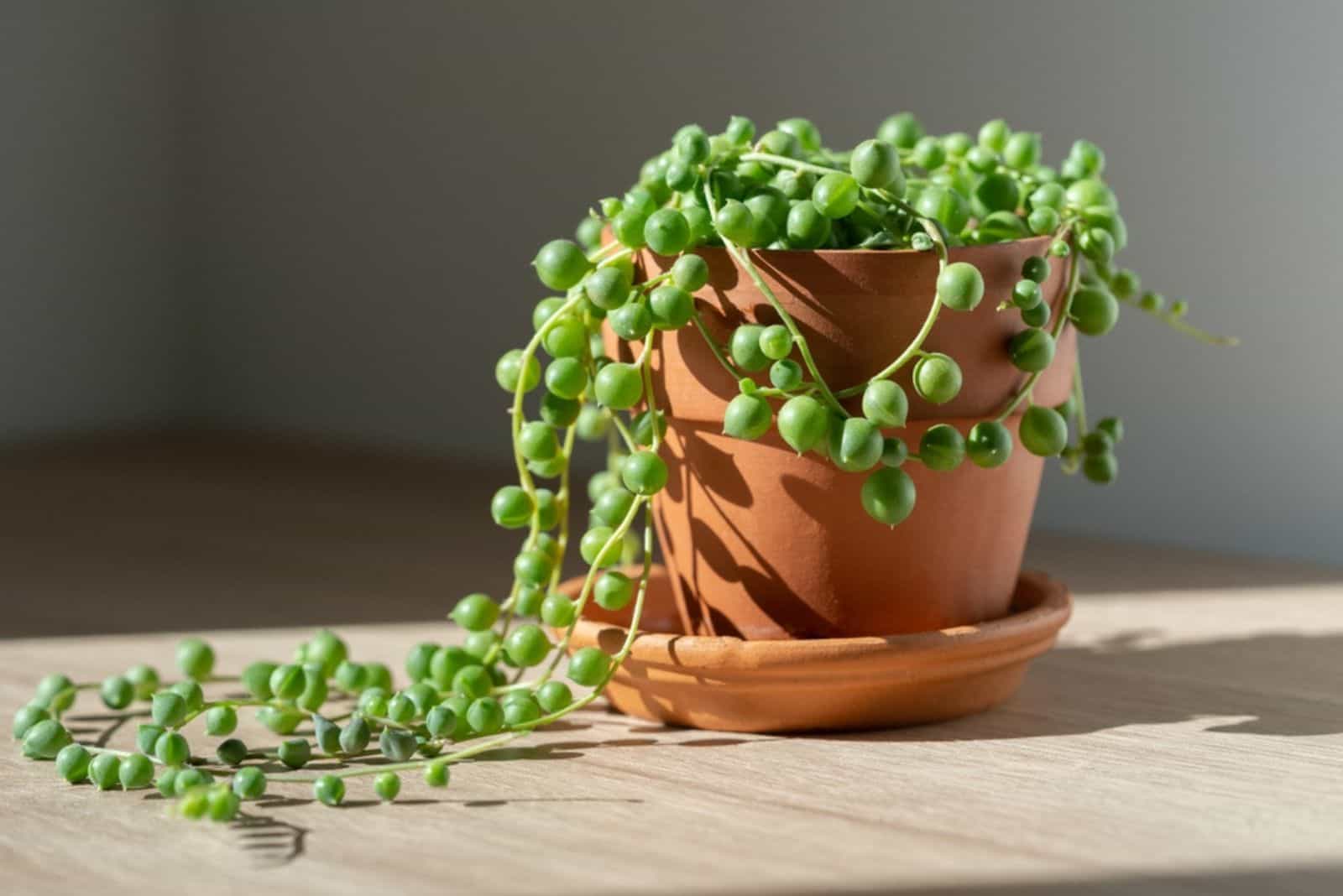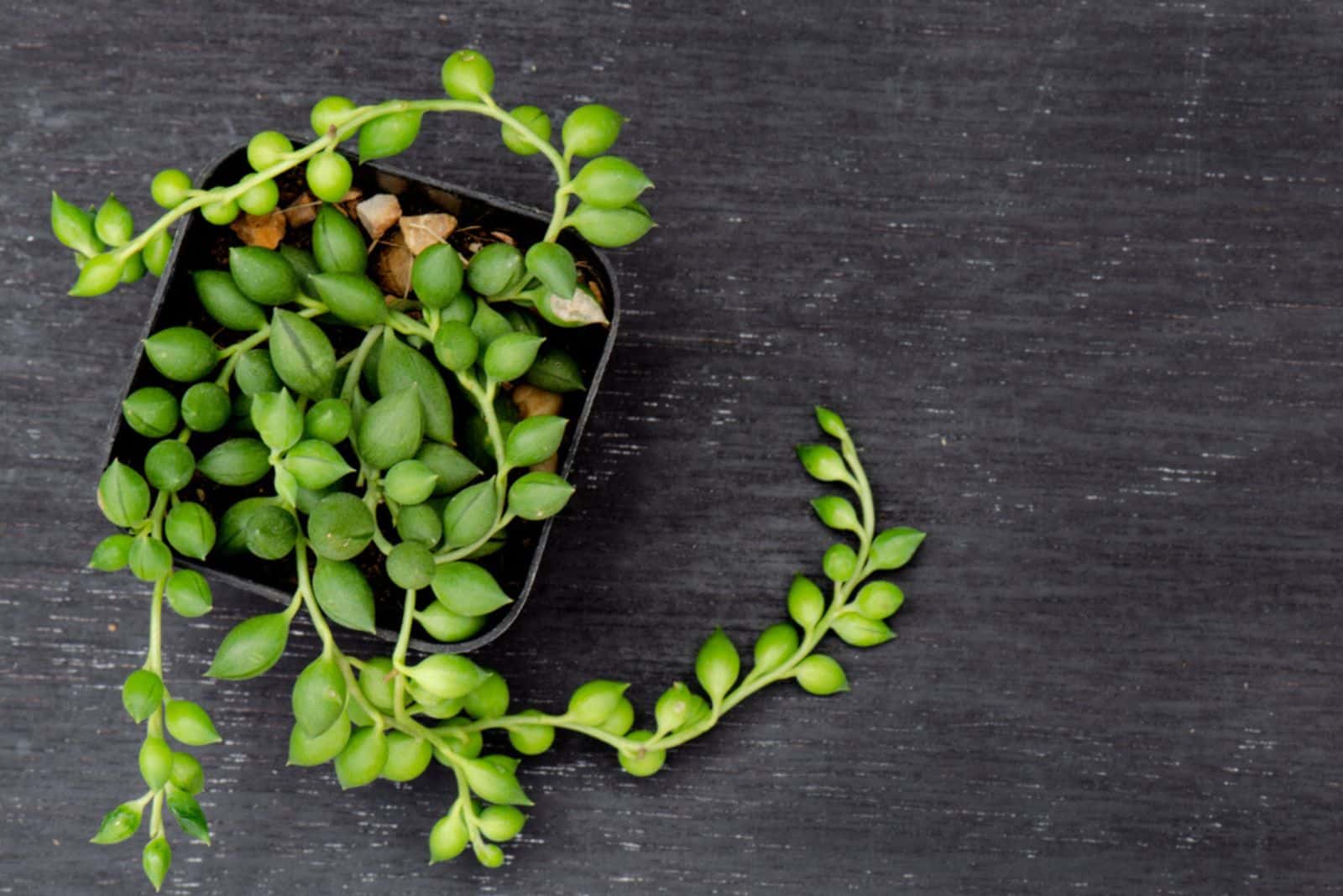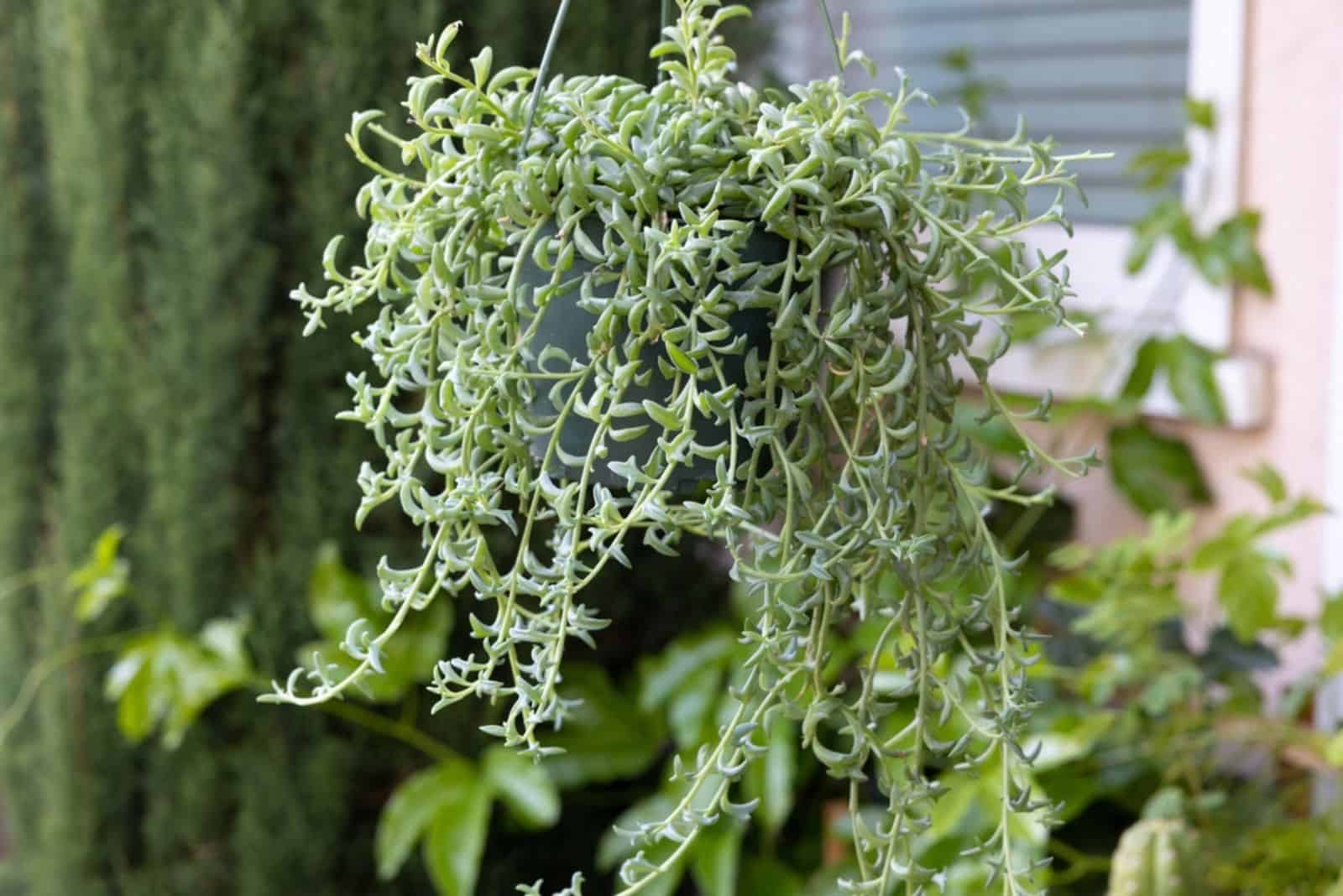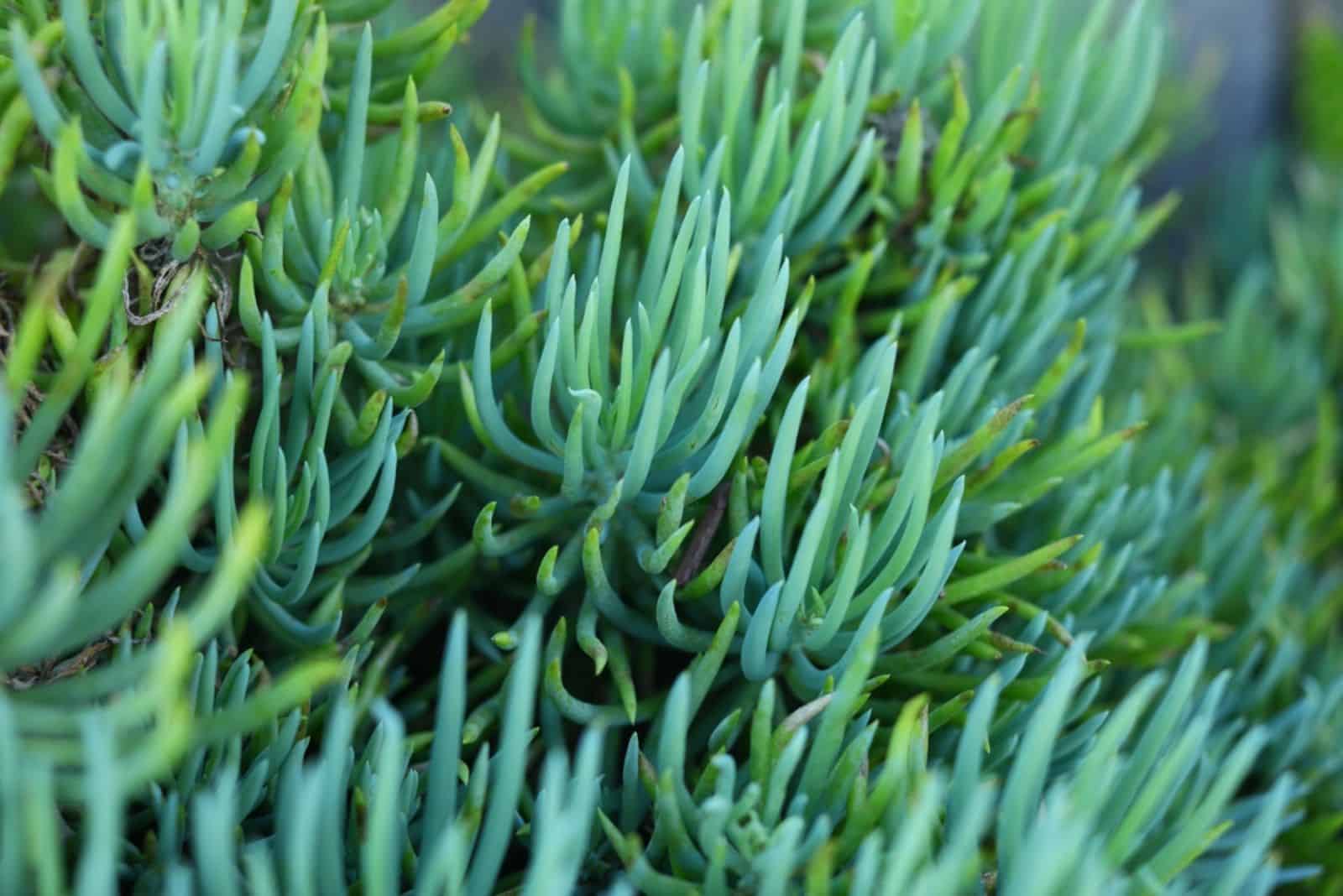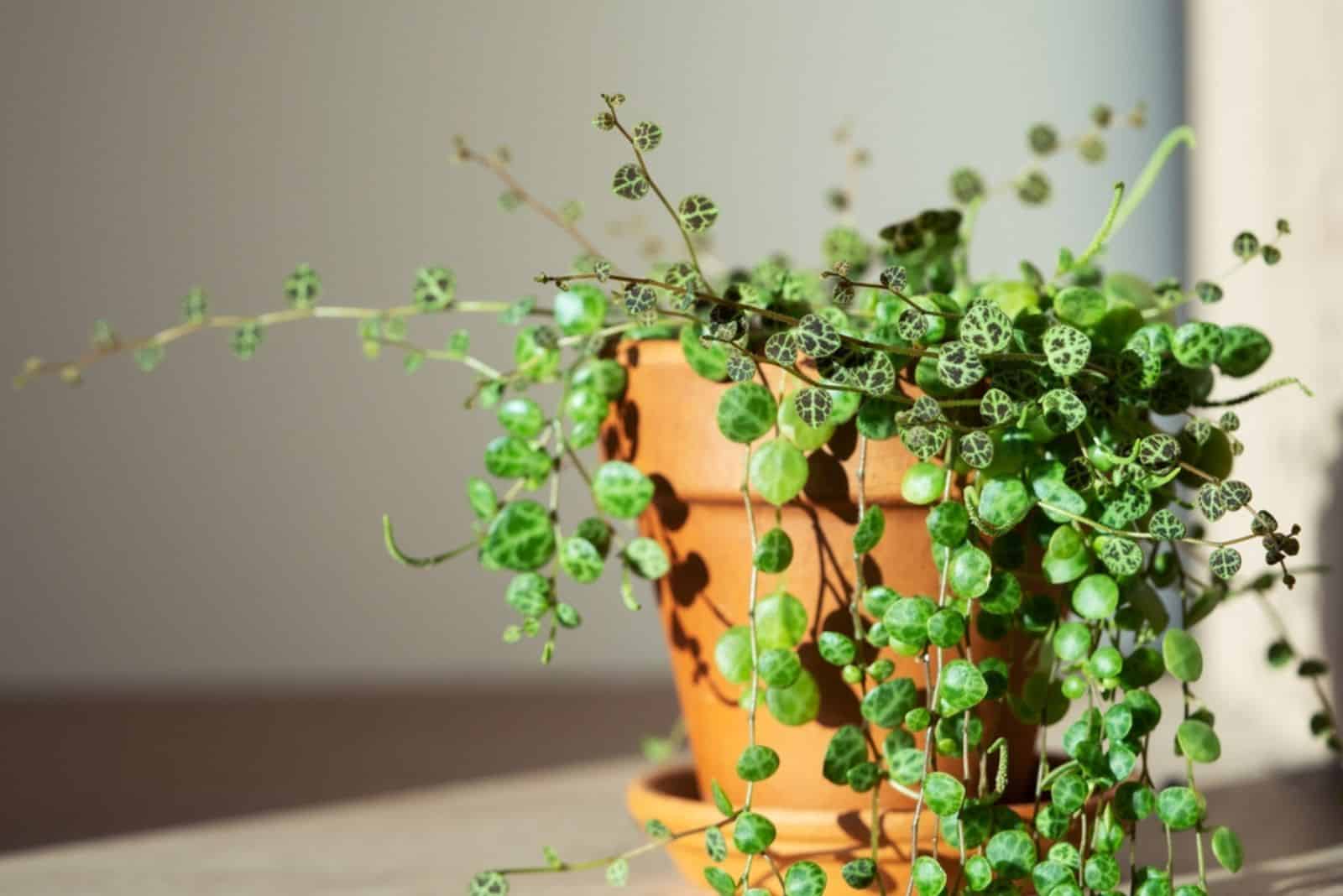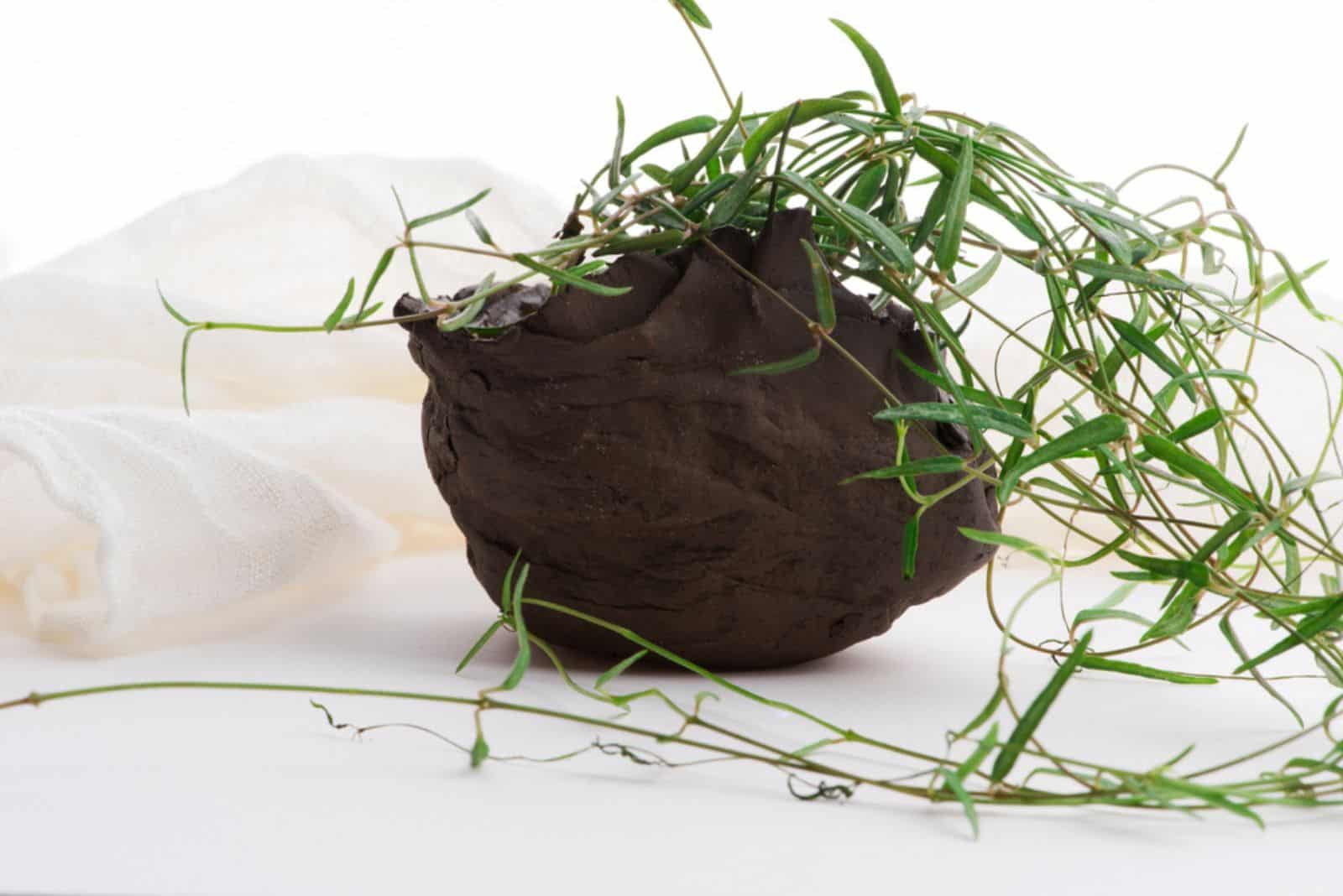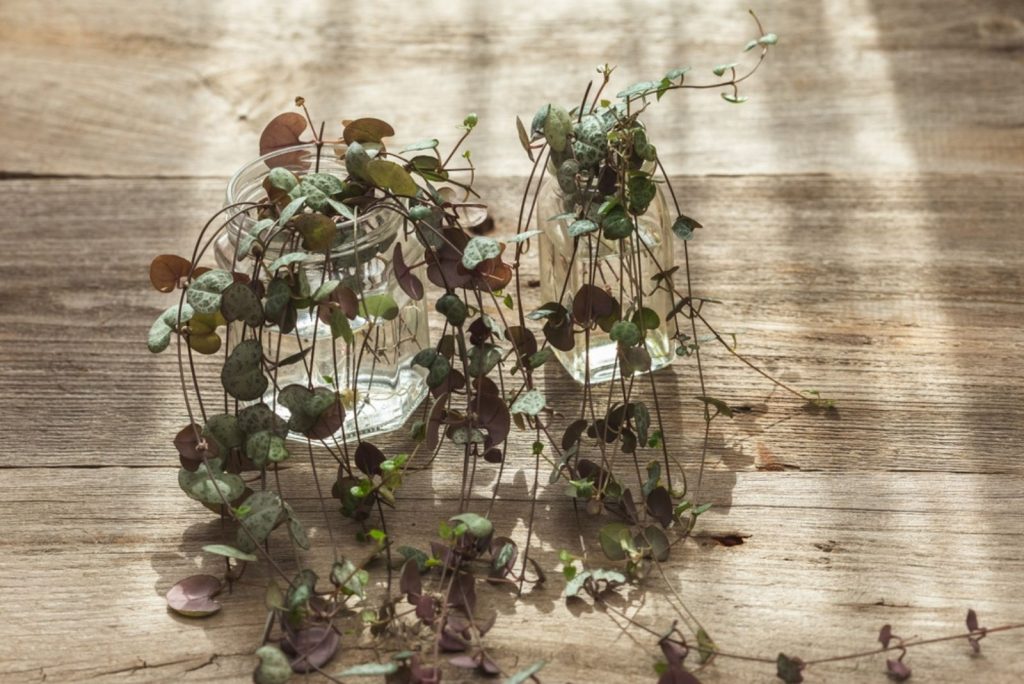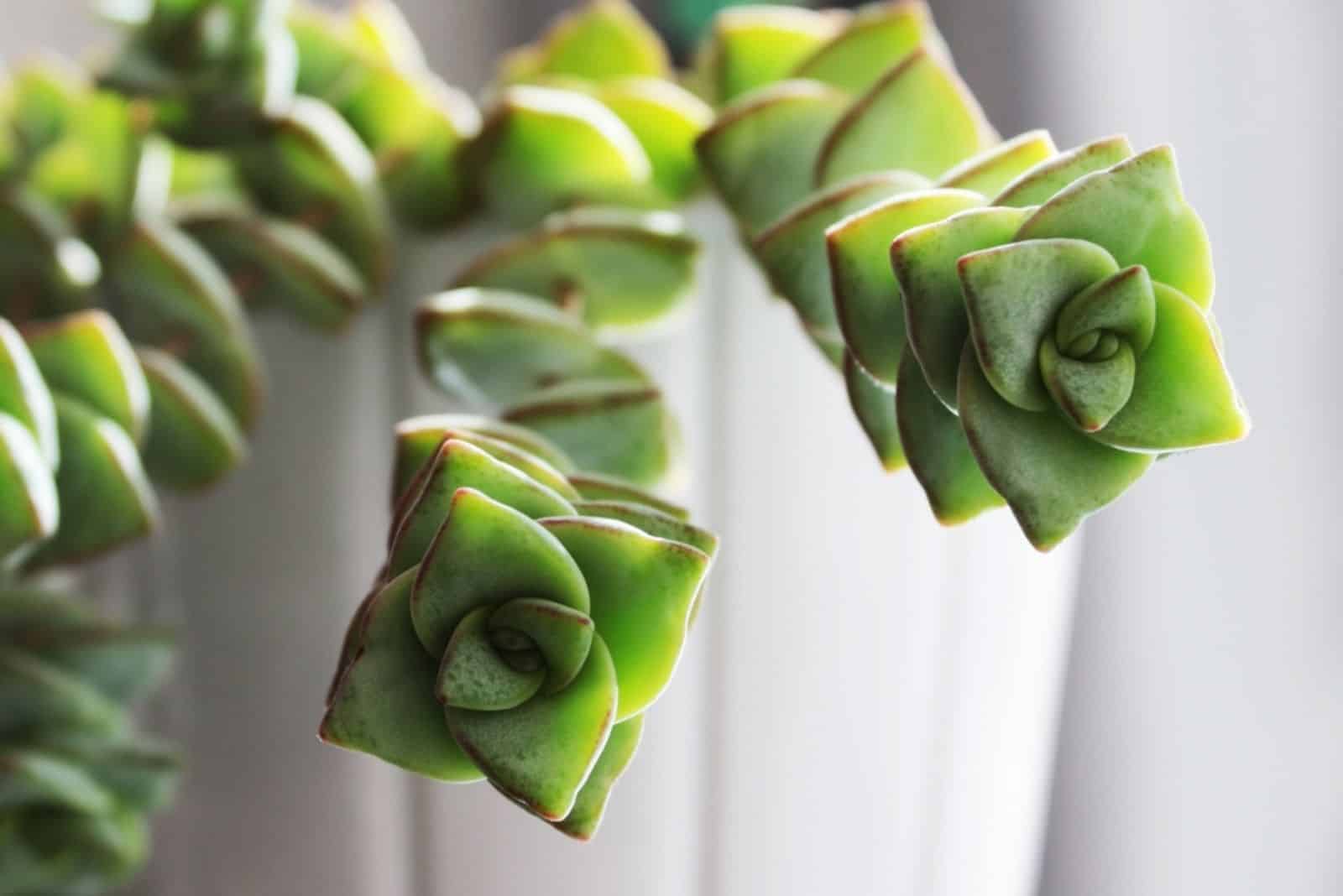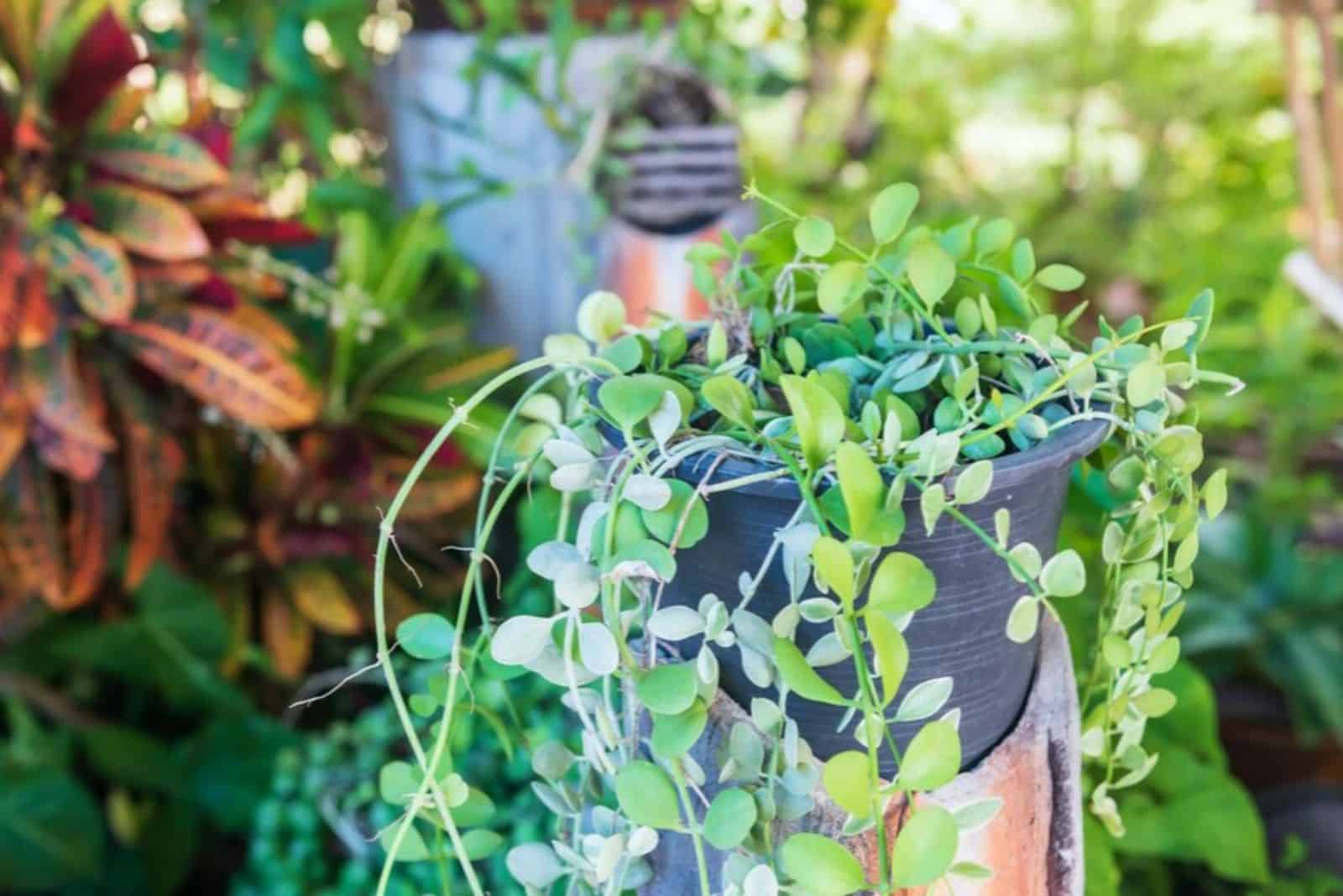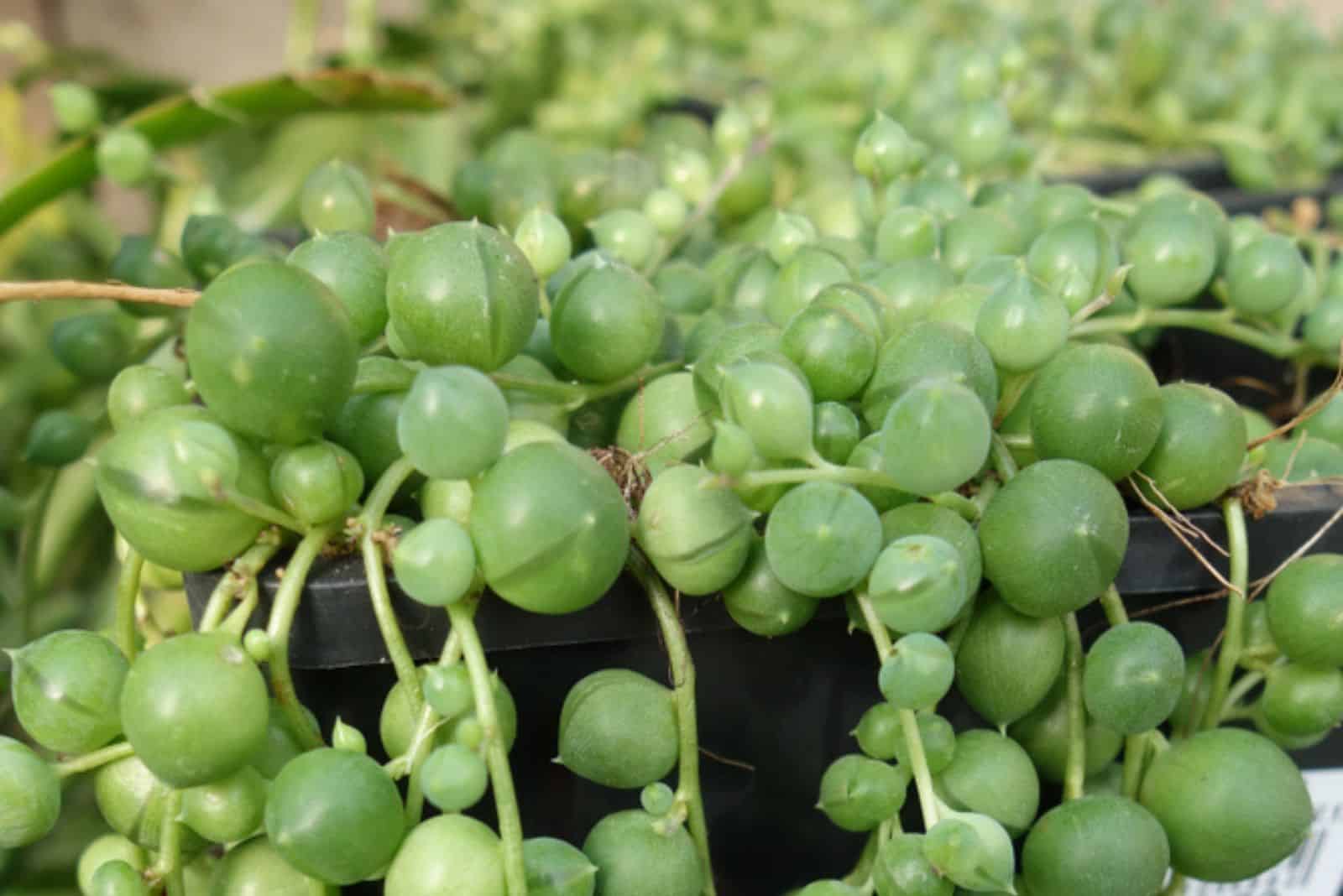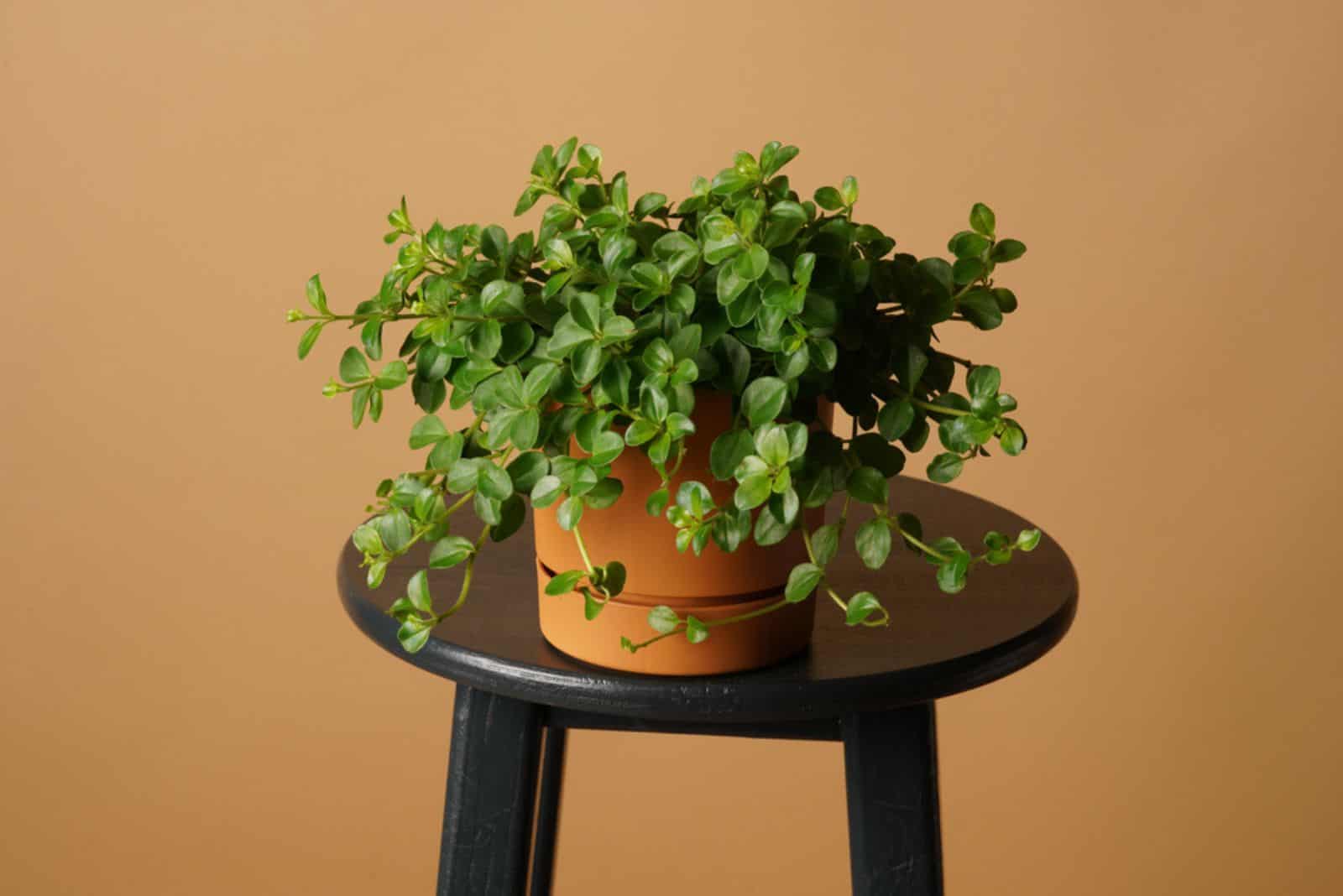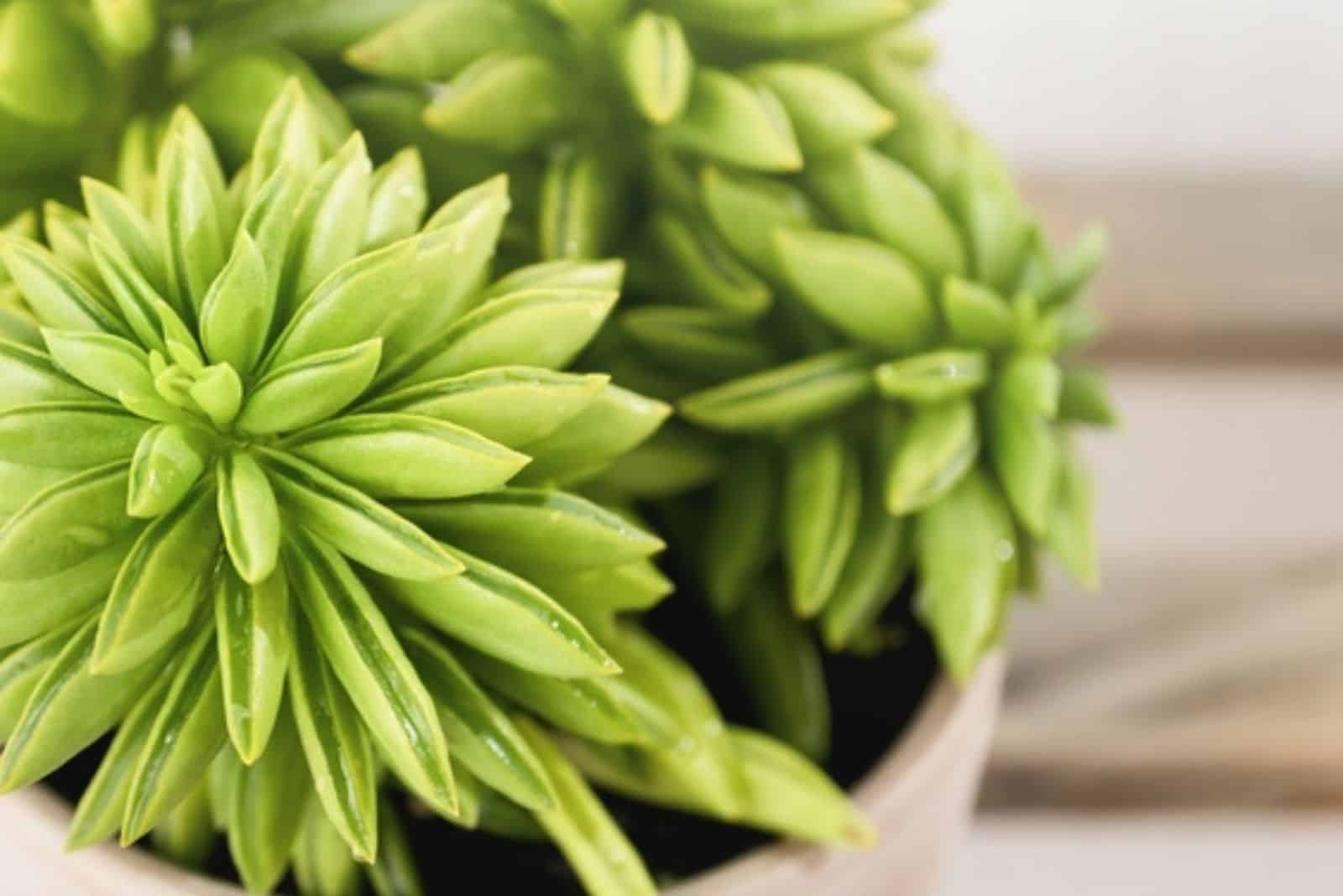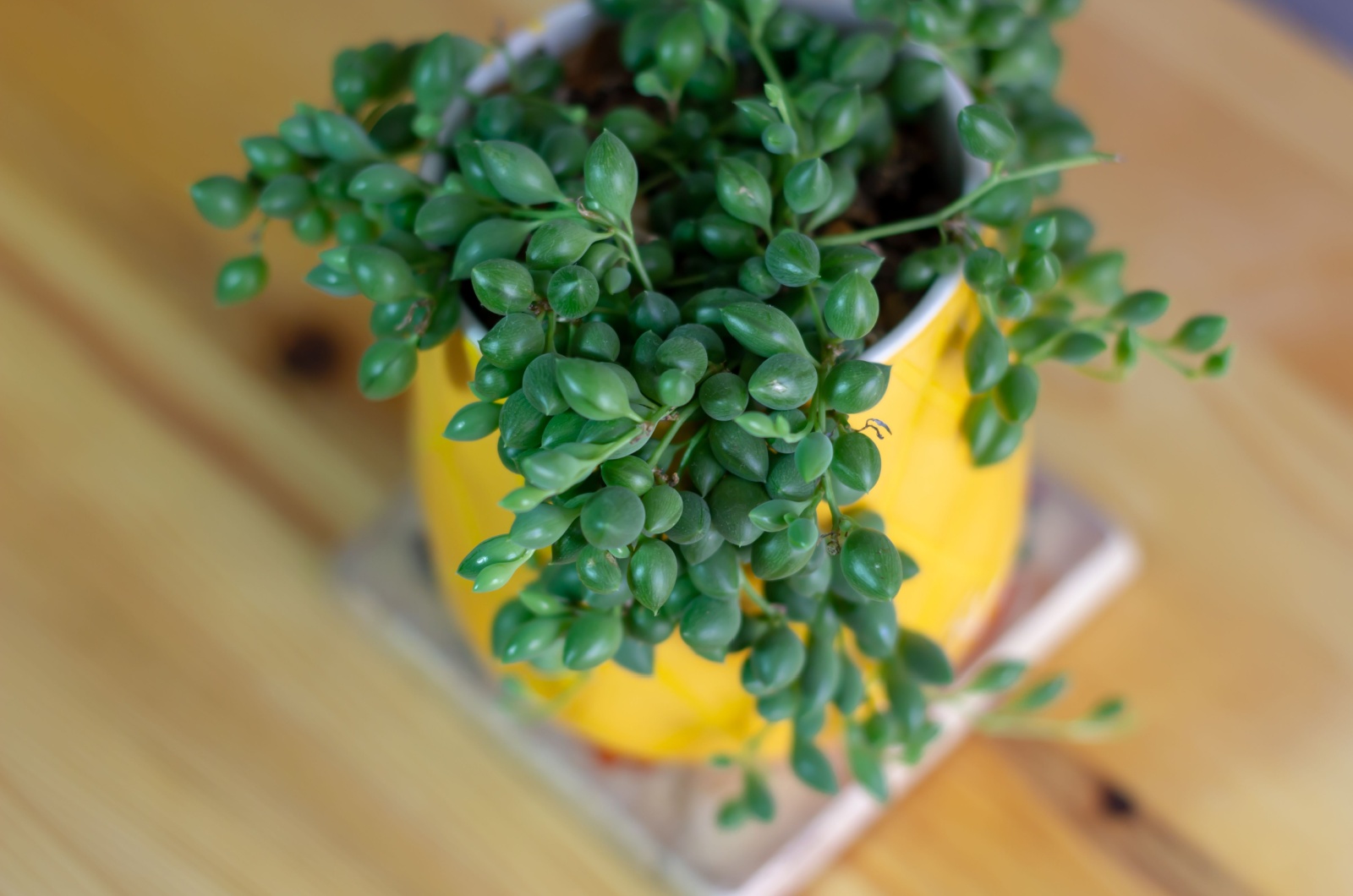The most beautiful houseplants are definitely string plants and succulents. These plants are low-maintenance and relatively easy to grow, and they also look absolutely amazing when swinging from hanging baskets.
Most of these string succulent plants originate from South Africa, so they can adapt to growing in various growing conditions.
If you have already grown succulents successfully, then you won’t have to worry about growing these lovely and unique plants.
So, if you are looking for pretty string plants, keep reading to find the one that best suits your style!
With so many beautiful string plants to choose from, I’m sure that you will be able to find one that fits your style. You can choose from the String of Pearls, String of Turtles, String of Needles, String of Tears, and many more!
Let’s dive in.
1. String Of Pearls (Curio Rowleyanus)
The String of Pearls is a well-known succulent you can add to your collection. This plant was formerly known as “Senecio rowleyanus”, though it goes by many nicknames, including the String of Beads. It’s distinguished by its intriguing pearl-shaped leaves. Although many like to refer to the leaves as having a pea form, I think the pearl reference suits it better.
The String of Pearls is the best choice if you want to grow a vining plant in a south-facing window.
Although they are grown all year round as vining plants, these plants naturally spread out as ground covers.
If given the proper plant care, the String of Pearls will also produce tiny white flowers.
There are no unique requirements when it comes to plant care. If you provide it with enough food and light, it will develop quickly.
The String of Pearls doesn’t require much maintenance, and it doesn’t have any serious health problems. To emphasize its beauty, grow it in a hanging basket!
2. String Of Tears (Curio Herreianus)
Put your tissues away, because this plant will bring you joy despite its common name, the String of Tears!
It is scientifically known as the Curio herreianus, although it was formerly known as Senecio herreianus. These plants belong to the Asteraceae family and originate from Nambia, South Africa.
When cultivated in hanging baskets, the Curio plant has a stunning appearance. It is still ideal for growing as a groundcover because it also has crawling stems.
The glossy leaves, which are what actually distinguishes this plant, are in the front. The name comes from their resemblance to raindrops or tears.
The trumpet-shaped, white flowers make this plant even more pretty.
Bright indirect sunshine, mild temperatures, low humidity, well-draining soil, occasional watering, feeding every two weeks (during the growing season), and annual repotting are all requirements for the String of Tears.
This plant is often mistaken for the String of Watermelons, which is a plant that has a similar leaf shape. Due to the variegations, the leaves often look like tiny watermelons!
3. String Of Dolphins (Senecio Peregrinus)
Imagine little dolphins swinging around in the air. A nice thought, right?
If so, then you should definitely get yourself a String of Dolphins plant. The Senecio articulatus, also known as the candle plant or hot dog cactus, and Curio rowleyanus, the abovementioned String of Pearls, are actually the parents of this hybrid plant.
This plant is a trailing succulent, and because of the way it grows, it has gained a lot of popularity. You can use a variety of supporting structures to aid the plant’s upward growth.
The string of dolphins can be cultivated in hanging pots so that its unusual leaves fall down, or you can get the dolphin-shaped leaves to climb on structures. I keep my string of dolphins near its cousin Senecio kleiniiformis.
The plant is even more beautiful because of the light green leaves’ distinctive dusty-blue undertone. The plant’s average size is 3 feet wide and 6 inches high.
When it comes to the plant care guide, it’s quite similar to other plants. The soil should be well-draining and porous, humidity moderate, temperature between 68 to 76 degrees Fahrenheit, and pruning occasional. You should provide it with enough bright indirect light and water it when the top few inches of the soil have dried out.
4. String Of Bananas (Curio Radicans)
Curio or Senecio radicans, otherwise known as the String of Bananas or the String Of Fishhooks, is yet another eye-catching hanging plant that is perfect for growing indoors.
The name of the plant comes from its distinctive leaves, which are shaped like bananas and have a glossy appearance. They also grow from extended tendrils.
This unusual plant, which may grow to around 36 inches long, is typically kept as a houseplant. If you provide it with support such as a moss pole, you can train the plant to climb. However, growers usually keep them in hanging baskets.
They also look absolutely stunning outdoors, though they require warmer climates for proper growth and development. To make things even better, these plants also produce pink and white flowers.
The String of Bananas plant will definitely bring some tropical vibes to your house.
This is a fast-growing plant that is relatively easy to take care of. Give your bananas enough sunlight and dry air, high temperatures, and soil that drains well. It will stay content and healthy for a very long time if you just water it when the soil has completely drained.
5. String Of Turtles (Peperomia Prostrata)
If you like turtles, then you are definitely going to love the String of Turtles plant!
This is a semi-succulent that originates from Brazil, unlike the above-mentioned plants, which are native to South Africa. Since they are members of the Peperomia genus and require similar care, you can grow them with other varieties of Peperomia houseplants.
The distinctive leaves of this plant, which are small, compact, and green with some creamy white variegation, are what makes it unusual. They actually look like little turtle shells.
It’s also intriguing to note that each of these leaves is affixed to a long stem that resembles a vine; as a result, it appears as though the tiny turtles are climbing up and down the strings. These hanging plants are ideal for growing in hanging baskets since the stems, which range in color from light green to orange, can get rather long.
The plant itself is quite small; it’s simply that they appear taller due to their extended vines. In contrast to many other tropical plants, the String of Turtle can go for long periods of time without getting any water. Still, you will have to water it from time to time.
To grow a healthy plant, keep it out of direct sunlight, ensure appropriate temperatures, and grow it in soil that is loamy and well-draining.
6. String Of Needles (Ceropegia Linearis)
The String of Needles is a special plant — it is an epiphytic and lithophytic plant species, which means that it grows on rocks and trees in its natural habitat.
It is a member of the Ceropegia genus and the Apocynaceae family. It got its name, linearis, in 1836 due to its long, blade-like leaves.
It grows up to 70 inches long and 20 inches wide.
Clusters of vivid magenta flowers are produced during its normal spring blooming period. The flowers are viable for about a week.
Its name fits perfectly given that the tiny leaves of the plant resemble little needles.
The plant care requirements are relatively simple — all you have to do is keep it in a temperature range from 50 to 86 degrees Fahrenheit and moderate humidity. The soil should be well-draining and porous. Let the soil to dry out in-between waterings.
7. String Of Hearts (Ceropegia Woodii)
This is probably one of the most popular String plants. Commonly known as the Rosary vine, the String of Hearts is known for its dark green, heart-shaped leaves that are covered with light green variegations. They produce long vines, which is why these plants look absolutely great hanging from the ceiling.
It’s quite easy to take care of this plant. However, you will have to be careful with watering otherwise you will end up overwatering your String of Hearts. Root rot often comes with overwatering, and it can completely ruin your plant.
You should water this plant only when the soil is completely dried out. It prefers warm temperatures and moderate humidity. For Ceropegia plants, a well-draining, porous succulent soil mixture is ideal. If you choose normal potting soil, improve the drainage by adding perlite and coarse sand.
Keep them away from full sun exposure, and fertilize them during the growing season.
If you already own a String of Hearts plant you can easily snatch some healthy stem cuttings from, then check out this String of Hearts propagation guide to get many more!
8. String Of Buttons (Crassula Perforata)
This trailing plant is as cute as a button!
The leaves of this succulent are compact and fleshy. They also have a triangular shape and an intense green color with red margins. This plant, also called the Necklace vine, is great for that subtle pop of color!
The care guide is quite similar to the previous plants — keep them warm and cozy, ensure that they grow in well-draining soil, and water them once the soil dries out.
You can also fertilize them during the growing season, though this is not a necessary step. They are slow growers, so you won’t have to worry about repotting them every season.
9. String Of Nickels (Dischidia Nummularia)
The Nummularia plant, which is native to Australia and Asia’s tropical regions, has grown to be one of the most desirable houseplants in the world.
The plant is commonly referred to as “the String of Nickels” because of its round, coin-like leaves.
The plant typically has foliage that is yellowish green. There is a brand-new cultivar with whitish-green variegated leaves called the Dischidia nummularia variegata or variegated String of Nickels.
This Dischidia plant can spread out to a maximum of 24 inches and grow to a length of about 18 inches.
Although the yellow and white flowers that Nummularia plants produce are lovely, the foliage is what really stands out. Fortunately, Dischidias don’t require much to flourish. Your plant will grow healthily if it has access to bright indirect light, warm temperatures, moderate humidity, and well-draining soil.
10. String Of Pickles (Othonna Capensis)
The Othonna capensis, otherwise known as the String of Pickles, Little pickles, and Ruby necklace, is another beautiful string plant that can be grown indoors.
The reddish-purple stem and lovely oval leaves of the ruby necklace are its most prominent features. When the plant is stressed, the bean-shaped leaves will turn a vibrant ruby red (as the name suggests).
This distinguishing characteristic definitely helps this plant stand out among trailing succulents, and collectors adore the striking ruby red hue. During droughts, these red cells gradually supply moisture to the rest of the plant, enabling it to survive without water.
With the exception of winter, yellow, daisy-like flowers are in bloom all year round. The fast-growing Ruby plant hibernates during the colder months.
The plant care requirements are similar to others — moderate humidity, temperatures above 50 degrees Fahrenheit, watering when the soil completely dries out, and occasional pruning with low-nitrogen fertilizer will encourage this plant to grow and thrive.
The ideal light conditions are full sun to partial shade.
11. String Of Lemons (Curio Citriformis)
Previously known as the Senecio citriformis, the String of Lemons plants is very similar to the abovementioned String of Tears plant. The leaf shape and sizes are similar; however, the String of Lemons plant has somewhat lighter leaves.
The growth habits and plant care requirements are pretty much the same.
All you have to do is ensure that the plant is warm and very well fed during the growing season. The ideal location for the String of Lemons would be somewhere with mild humidity and lots of bright light.
Don’t expose the plant to direct sunlight for too long or you will end up with wrinkly tiny lemons!
12. Green Button Plant (Peperomia Rotundifolia)
Small, spherical leaves that resemble tiny buttons are produced by the lovely Peperomia Rotundifolia. These leaves have a glossy finish and fine, delicate veining. The stems grow upright when they are young, and if planted with other examples and kept trimmed, these upright stems will provide a big, bushy pot.
The stems will trail from the pot and gradually entwine to produce a thick drape, giving the plant a bushy appearance if left to grow long.
These plants have fairly simple maintenance because they are epiphytes, which means they can grow on other plants or objects. They do best in soil that drains well with some shade. If you want to grow your plant in a hanging basket, you should mist it frequently.
13. String Of Tacos (Peperomia Axillaris)
We have saved the best for last!
The Taco plant, otherwise known as the String of Tacos or Peperomia Taco, is one of the cutest plants that you can grow indoors. Seriously, it looks like tiny tacos are flying in the air!
This plant produces small, compact green leaves that look like tiny tacos. The plant’s main stem is where the leaves are formed, yet it has the potential to branch out and add more leaves from the side stems.These plants produce relatively tall, candelabra-like flowers in perfect growing conditions.
This is a tiny succulent that doesn’t change much throughout the course of its lifetime, making it the ideal plant for adorning small places.
These plants are also quite easy to take care of. All you need to do is make sure they have mild temperatures, lots of light, and moist potting soil. Even fertilization need not be a concern if you are using nutrient-rich soil.
To Sum Up
That’s our list of the prettiest String plants that you can grow indoors!
With so many great options, I’m sure you will find one for yourself. If you are a gardening beginner, don’t worry — most of these plants are quite easy to grow.
Make sure that they are warm enough, water them from time to time, and fertilize them during the growing season. The light conditions might vary between different plants, so you should always check a detailed care guide for any plant you own!
I hope that this article was helpful.
Until next time!


